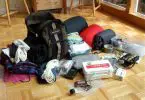Finding the right bag liner to increase the warmth during your sleep requires you to dig deep into your pockets. They are quite expensive. However, with a DIY sleeping bag liner, you can be sure to enjoy the same warmth but at a much-reduced cost.
See also: How to Wash Down Sleeping Bag: Plus Some Sleeping Bag Care Tips You Should Know
Sleeping bags are unavoidable when you are going to spend the night outdoors or while camping in areas where the temperatures are very likely to be low at night. A cold night can ruin the perfect camping outing and only just because you could not find the right sleeping bag to fit into your budget.
The liner on the sleeping bag serves pretty much the same purpose as that of sheets on mattresses; adding warmth and keeping high levels of hygiene. The liner acts as an easy to wash barrier, preventing your sleeping bag from getting dirty easily. Have you tried washing a sleeping bag? It is not one of the easiest tasks around and the sleeping bags takes like forever to dry.
Adding one to your sleeping bag is, therefore, advantageous in the long run if you don’t have one. Having an extra one is also a good idea too in the unlikely event that the first one gets damaged.
You just have to find the right fabric for the liner and have a few items to sew your liner to the bag. The feeling of pride that comes after you are done is always priceless. You look at it and say yes you made that, and it is pretty warm too.
Today, we are going to provide you with some of the methods you can use to make your own sleeping bag liner at home, so you do not have to buy one. They are quite expensive by the way. If you’re interested in making a DIY sleeping bag then you can check our article on how to make your own sleeping bag. The next time you are traveling or backpacking you will not have to worry about the cold. The methods are named after the people who provided them. For the top sleeping pad for side sleepers, check out our earlier article.
The TwoCanoe method
This amazing method of making your own sleeping bag is provided by blogger Ellen, writing for the two CANOE blog. This method is used to make a low-cost liner that can double up as sleeping bags during warm weather when a lot of covers are not necessary.
There is an inclusion of a zipper which slightly increases the amount of time and effort required to make it.
Materials
- Any length of fleece that is of equivalent size to your sleeping bag. You can choose the pattern and how much thickness you want.
- Pins of the straight type.
- A pair of scissors.
- Sewing mechanism (You can use a machine or use your hands to sew when you cannot find a machine)
- A zipper.
- A fabric marker (it should not stain or spread to other areas of the fabric)
- Strands of sewing thread.
Steps
- With the right side of the fleece facing inside, fold it along its length. Trace the shape of your current sleeping bag as you make its outline with the fabric marker onto the liner fabric. Provide some allowance for sewing of the seams. You can base your designs on the mummy or barrel bags.
- Keep the fabric folded together and cut along the folded side. This makes the sewing of the zipper a much easier task. Using the pins, pin along one side of the cut sides. Sew that side with the loosest of stitches as you will have to remove the thread.
- Open up the fabric, with the seam facing upwards. Apply a butterfly outline along the whole fabric length. Place the zipper at the point of your convenience, making sure to allow an allowance from the top for a smooth finish around the liner opening.
- Line the zipper with the seam you had created, while facing downwards. Pin the zipper down and sew it on both sides. The stitch you made in (2) that was loose can now be removed using the pair of scissors.
- Do some realignment so that the liner is on its right side inwards. The open edges are then pinned and sewed.
- Now to the top edge, fold the edge, pin it in place, and sew it up. Your liner is now complete. You can sew other features that you may want (like the drawstring), but this basic steps should do the work of producing you the liner that will give you the extra warmth you will need during those cold nights and also act as a sleeping bag itself during warmer nights
Backpacker method
Annette McGivney from Backpacker says that this simple homemade project is capable of adding a great deal of warmth to your sleeping bag (approximately up to 10 degrees centigrade). Buying the sleeping bag liner itself costs upwards of up to $80.
However, you can simply buy fabrics of high quality and sew it up together to make the liner. It is as simple as just folding the fabric and stitching the edges together. It only takes a couple of hours (if your skills on the sewing machine are not that great).
Otherwise, you should be done in minutes.
Materials
- A liner of your preference. It should be warm and light. Adding more weight is not beneficial.
- Pattern making paper (can be newsprint or ordinary paper for packing)
- A fabric marker
- A small length of ribbon for attaching the liner to the sleeping bag.
- A pair of scissors
- Threads for sewing
- Sewing machine or needle (choose the one you are most comfortable while using and can readily afford.
Steps
- Close your sleeping bag and place it on the floor and determine the amount of space it occupies while lying flat. Double the space to estimate how much of the fabric you will need. Place the bag on the marking paper and trace its outline on the paper. Put a mark where the bag is zipped up to.
- Using the scissors, cut the marked outline to produce a paper representation of the sleeping bag liner. Carefully place the pattern over the fabric and pin it if necessary to maintain it over the fabric.
- Trace the fabric around the outline of the paper marker. Make sure not to cut the side that was folded.
- To allow for a space to accommodate a pillow for extra comfort, outline a rectangular shape on the fabric while still folded. This should be similar to the sleeping bag width.
- Open the fabric out to expose the side not to be in contact with your skin. Sew the bottom and more than half way through the other open side. Do not sew too close to the edges. This should allow for proper sealing of the edge.
- Sew the ribbon pieces at the bottom of the liner fabric. Equally, space these ribbons for attaching to the sleeping bag. They are easy to remove too when you want to clean the liner after some time.
- Turn the bag on to the other side, the side always inside to be out. Then stitch the liner onto the sleeping bag. Use loose stitches that will be easy to remove later.
- Fold the edge on the opposite side to form a neat hem. Make the end into a rectangle for the pillow. Provide a closing mechanism that can be fitted into the sleeping bag hood. Sew only on three sides of the rectangle. The fourth side is where stuffing is placed for the pillow.
- Your pillowed sleeping bag liner is now ready. Turn it now to the right side out.
Silken sleeping bag liner
Silk fabrics provide some of the best sleeping bag liners. Silk is lightweight, easy to wash and also dries up very fast. You do not have to wait for hours for the liner to dry before using it. You can just wash it as you are about to leave for camping and air it on your car. Provide a fixing mechanism so that it does not fall off.
Silk is also soft on the skin and makes your sleep more comfortable. The guys at DIY provide one of the simplest methods for making a silken sleeping bag liner. We will give you a summary of the whole steps.
Materials
- Silk fabric
- Zipper
- A pair of scissors for fabrics
- Spools of threads that match the fabric (you do not want the stitches to look rather awkward due to any contrasts)
- Sewing needle/machine
- Elastic
Steps
- Determine the size of the sleeping, which is the determinant of the amount of silk material you will need for the sleeping bag liner. Too much material leads to unnecessary wastes, and inadequate material makes the liner to be less comfortable. This beats the purpose of the silk
- Cut out the silk according to the measurements you had taken. The pattern should outline itself nicely with that of the sleeping bag that it will go into. Accuracy and care are very necessary here to prevent the edges from curling and buckling after cutting.
- Transfer the silk fabric to the sewing machine and sew the edges nicely, giving room for hemming of the edges. The fabric should be first folded through the middle before sewing.
- Cut out a circular piece of fabric for the bottom part of the sleeping bag liner. This makes the legs fit in smoothly, allowing for better comfort as you turn in your sleeping bag as you sleep.
- Sew up the zipper (it is recommended it be on the remaining right-hand side). The zipper plays the role of an entrance into the sleeping bag liner.
- Lastly, attach the elastic to the liner. These will be used to join the liner to the sleeping bag. Turn the bag and liner inside out, and you are good to go.
This sleeping bag is very easy to sew and takes no time to complete. It saves money and has the added advantage of being able to be patterned to your desires regarding color and sizes.
Method 4
This is another method that you can apply and still get good results and better insulating properties from your sleeping bag liner.
It is adopted from MyTopSleepingBag.
Materials
- Sleeping bag liner material, the size should be same as that of the sleeping bag. Double the bag size to get the size of material for the liner (you will fold it)
- A sleeping bag
- Popper fasteners (the ones for heavy duty, eight of them)
- Needle for sewing/sewing machine
- Spool of sewing thread
- A pair of scissors
Steps
- Place the liner material on the floor and then the bag onto it. Cut around the sleeping bag, to transfer its outline to the material. Leave the folded edge uncut.
- Make the right side of the material face out and sew the cut edges some distance from the edge. Leave the top end of the liner for the head. Provide another line of sewing for increased strength of the seams.
- The liner that has been stitched is then turned inside out again, including the sleeping bag. Position the fasteners on the bag and ensure they are spaced equally on the three sides (3 to the right, 1 through the middle, 1 at the center bottom and the 3 to the left). Sew these fasteners to the liner and bag. The liner is now firmly held to the bag.
- Now turn back the liner and bag onto their right side and fasten back the poppers. There is an extra length of material around the head area. Fold it and sew the edge. This does not allow for fraying to occur.
- You can try out making other liners with various materials to have a feel of their various properties. Materials vary in terms of warmth, feel and ease of washability.
Craig turner’s fleece bag liner
Fleece materials are generally made from fibers of sheep or yak. They possess very good warmth in cold conditions. You can hand wash or machine wash these types of liners. Their drying rate exceeds that of cotton.
Materials
- Lightweight fleece
- Zipper (36 inches)
- Pins
- A pair of scissors
- Needle or sewing machine.
- Cardboard
Steps
- Place the cardboard on the floor or table
- Lay the fabric on the cardboard and spread the sleeping bag on it. It should be zipped.
- Trace around the sleeping bag with a marker to get the shape of the liner
- Cut out the pattern except on one side. This side you cut up to the shoulder then fold it at this place not cut.
- Cut out the pattern and sew them together.
- Have the two patterns on their sides out, pin them together and sew, leaving the part where the zipper goes into.
- Use the pins to hold the zipper in place as you sew it in place. This is done at the point where you left in step six above.
- Turn the sleeping bag back to the right side and cut a piece from where the shoulder position will be. The cut piece can find a use for the hood pocket.
Summing it up
Sleeping bag liners are a great way of pumping up the warmth in your sleeping bag. They can add up to 100C to you. They do not only provide warmth, but they also keep away the dirt from the sleeping bag from reaching you.
The sleeping bag liners can be likened to sheets on our mattresses. Who of us would sleep on a mattress without sheet? Maybe none. Consider it as the sheet in a sleeping bag.
A properly sewn sleeping bag liner can also act as a sleeping item on its own during warmer temperatures. When you have one or two, you can consider yourself to be having a couple of “sleeping bags.”
The liners also minimize the number of times you have to wash the sleeping bag. Since they are the ones always in contact with your body, all you have to do is remove the liner and wash it. There are liner fabrics that dry up really fast like silk, so you do not have to worry about it being still wet when night comes.
Sleeping bag liners are always very expensive. However, you can spend a considerably small amount and get a better or equally capable liner when you make one at home. The steps mostly require a material, threads and a sewing machine/needle. For the best sleeping bag liner, check out our piece on this topic.
So how do you like out DIY projects for creating your own sleeping bag liner? Perhaps you have a DIY tip that you can share with us? Let us know in the comments!
Featured Image Source: https://www.pexels.com/photo/woman-in-gray-jacket-lying-on-bed-5994748/








